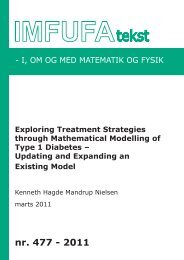ABSTRACT ALGEBRAIC STRUCTURES OPERATIONS AND ...
ABSTRACT ALGEBRAIC STRUCTURES OPERATIONS AND ...
ABSTRACT ALGEBRAIC STRUCTURES OPERATIONS AND ...
Create successful ePaper yourself
Turn your PDF publications into a flip-book with our unique Google optimized e-Paper software.
A subset I is said to be et ideal of the ring R, if I is a subgroup of the underlying<br />
additive structure and is closed wrt to multiplication by any element in the ring.<br />
This can be expressed by<br />
I + I = I<br />
RI = I<br />
IR = I<br />
126. Theorem: The kernel is an ideal.<br />
Let f be a homomorphism of the ring R1 into the ring R2. Then the kernel of<br />
f is an ideal<br />
Proof : Let K denote the kernel of f. Then f a homomorphism between the<br />
underlying groups with kernel K, which therefore is a subgroup of the underlying<br />
group in R1.<br />
This means that the first condition in the definition of ideals is fulfilled.<br />
The second condition: Let k ∈ K, r ∈ R then f(kr) = f(k)f(r) = 0f(r) = 0.<br />
Consequently kr ∈ I. Analogously for rk ∈ I.<br />
127. Theorem: The quotient wrt to an ideal is a ring<br />
Let I be an ideal in the ring R. Then I is a normal subgroup of the underlying<br />
additive group R. Let R/I denote the quotient group. Then the equivalence<br />
relation associated with I is compatible with the ring structure on R and the<br />
quotient structure R/I is a ring.<br />
Proof : We must show that the multiplication is compatible with the equivalence<br />
relation associated with I. Therefore let x1 ∼ y1 and x2 ∼ y2. This<br />
means per definition that x1 − y1 ∈ I and that x2 − y2 ∈ I. We use the good<br />
old trick to express a difference between two products by the difference of the<br />
factors to get<br />
x1x2−y1y2 = x1x2−x1y2+x1y2−y1y2 = x1(x2−y2)+(x1−y1)y2 ∈ IR+RI<br />
and by the properties of an ideal we have that RI + IR = I + I = I and<br />
so we have proved that x1x2 ∼ y1y2. Therefore the quotient structure is well<br />
defined and the product is given by the formula [x][y] = [xy] or in other words<br />
(x + I)(y + I) = (xy) + I. It is easy to check that this product makes the<br />
quotient a monoid with [1] as neutral element for multiplication. To check that<br />
this multiplication is distributive wrt addition is again routine. So the quotient<br />
is a ring.<br />
65
















